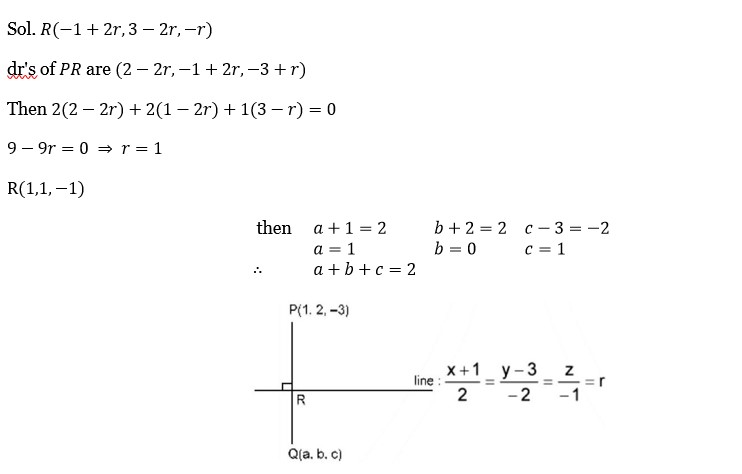Three Dimensional Geometry
Get insights from 212 questions on Three Dimensional Geometry, answered by students, alumni, and experts. You may also ask and answer any question you like about Three Dimensional Geometry
Follow Ask QuestionQuestions
Discussions
Active Users
Followers
New question posted
2 months agoNew answer posted
2 months agoContributor-Level 10
The equation of the plane passing through the line of intersection is:
(2x - 7y + 4z - 3) + λ (3x - 5y + 4z + 11) = 0.
The plane passes through the point (-2, 1, 3).
(2 (-2) - 7 (1) + 4 (3) - 3) + λ (3 (-2) - 5 (1) + 4 (3) + 11) = 0
(-4 - 7 + 12 - 3) + λ (-6 - 5 + 12 + 11) = 0
(-2) + λ (12) = 0 ⇒ 12λ = 2 ⇒ λ = 1/6.
Substitute λ back into the equation:
(2x - 7y + 4z - 3) + (1/6) (3x - 5y + 4z + 11) = 0
Multiply by 6:
6 (2x - 7y + 4z - 3) + (3x - 5y + 4z + 11) = 0
12x - 42y + 24z - 18 + 3x - 5y + 4z + 11 = 0
15x - 47y + 28z - 7 = 0.
This is the equation ax + by + cz - 7 = 0.
So, a=15, b=-47, c=28.
We need to find the value of 2a + b
New answer posted
2 months agoContributor-Level 10
Let the equation of the plane passing through (1, 2, 3) be:
a (x - 1) + b (y - 2) + c (z - 3) = 0
The plane contains the y-axis, which has direction ratios (0, 1, 0).
Therefore, the normal to the plane must be perpendicular to the y-axis.
a (0) + b (1) + c (0) = 0 ⇒ b = 0
The equation becomes: a (x - 1) + c (z - 3) = 0
ax + cz = a + 3c
The plane also passes through the origin (0,0,0) since it contains the y-axis.
a (0) + c (0) = a + 3c ⇒ a + 3c = 0 ⇒ a = -3c
Substitute a = -3c into the plane equation:
-3c (x - 1) + c (z - 3) = 0
-3 (x - 1) + (z - 3) = 0
-3x + 3 + z - 3 = 0
-3x + z = 0 ⇒ 3x - z = 0
New answer posted
2 months agoContributor-Level 9
Let A (α, 0,0), B (0, β, 0), C (0,0, γ), then the centroid is G (α/3, β/3, γ/3) = (1,1,2).
α = 3, β = 3, γ = 6
∴ Equation of plane is x/α + y/β + z/γ = 1
⇒ x/3 + y/3 + z/6 = 1
⇒ 2x + 2y + z = 6
∴ Required line passing through G (1,1,2) and normal to the plane is (x-1)/2 = (y-1)/2 = (z-2)/1.
New answer posted
2 months agoContributor-Level 10
Equation PQ
(x-1)/2 = (y+2)/3 = (z-3)/ (-6) = λ
Let Q = (2λ + 1, 3λ − 2, −6λ + 3)
Q lies on x - y + z = 5
⇒ (2λ + 1) − (3λ − 2) + (−6λ + 3) = 5
⇒ λ = -1/7
Q = (5/7, -17/7, 15/7)
∴ PQ = √ (2/7)² + (3/7)² + (6/7)²)
New question posted
2 months agoNew question posted
2 months agoTaking an Exam? Selecting a College?
Get authentic answers from experts, students and alumni that you won't find anywhere else
Sign Up on ShikshaOn Shiksha, get access to
- 65k Colleges
- 1.2k Exams
- 679k Reviews
- 1800k Answers

